I have always been fascinated by Japanese cuisine, and sushi has always been a dish that has intrigued me. Sushi is a traditional Japanese dish that has become popular all over the world.
It is a dish that is made up of small portions of raw fish or vegetables, combined with sticky rice, and wrapped in seaweed. But what does sushi taste like?
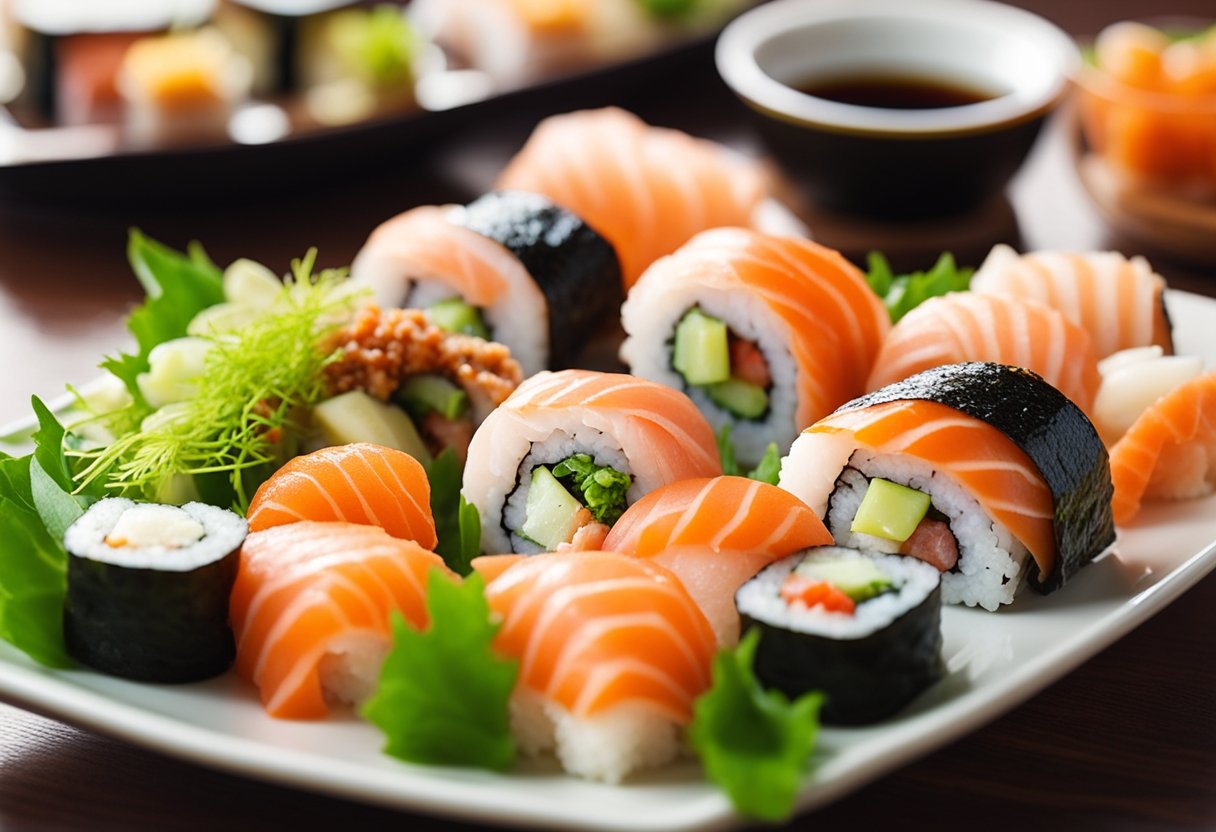
Understanding sushi is key to understanding its taste. Sushi is not just raw fish and rice, but a combination of flavors and textures that come together to create a unique culinary experience. The flavor profile of sushi is subtle, with a balance of sweet, salty, and savory notes.
The rice is slightly sweetened with vinegar, while the fish provides an umami flavor that is rich and satisfying. The texture of sushi is also an important aspect of its taste, with the soft and sticky rice contrasting with the firm and fresh fish.
Key Takeaways
- Sushi is a traditional Japanese dish that combines raw fish, sticky rice, and seaweed.
- The flavor profile of sushi is subtle and balanced, with sweet, salty, and savory notes.
- The texture of sushi is an important aspect of its taste, with the soft and sticky rice contrasting with the firm and fresh fish.
Understanding Sushi
Sushi is a traditional Japanese food that has become popular worldwide. It typically consists of vinegared rice, known as sushi rice, combined with other ingredients such as seafood, vegetables, or meat.
The combination of these ingredients creates a unique taste that is both savory and sweet.
One of the most popular types of sushi is nigirizushi, also known as hand-pressed sushi. This type of sushi consists of a small ball of sushi rice topped with a slice of raw fish or other ingredients.
Nigirizushi is often served with a small amount of wasabi and soy sauce.
Another type of sushi is maki, which is made by rolling sushi rice and other ingredients in a sheet of seaweed. Maki is often cut into bite-sized pieces and served with soy sauce and pickled ginger.
Some popular types of maki include the California roll, which typically consists of avocado, crab meat, and cucumber, and the tekka maki, which is made with tuna.
Temaki sushi, also known as hand rolls, are another type of sushi that is popular in Japan. These are made by wrapping sushi rice and other ingredients in a cone-shaped piece of seaweed. Temaki sushi is often eaten as a snack or as part of a larger meal.
Chirashi sushi is a type of sushi that is served in a bowl and consists of sushi rice topped with a variety of ingredients such as raw fish, vegetables, and egg. Inari sushi is another type of sushi that is made by stuffing sushi rice into a pouch of fried tofu.
Overall, sushi is a diverse and versatile food that can be enjoyed in many different ways. Whether you prefer hand-pressed sushi, sushi rolls, or chirashi sushi, there is sure to be a type of sushi that suits your taste.
The Flavor Profile of Sushi
As a sushi lover, I can confidently say that sushi has a unique flavor profile that is hard to describe. Sushi is a combination of different flavors that come together to create a harmonious taste.
In this section, I will explore the flavor profile of sushi and break down its different components.
The Taste of Sushi
At its core, sushi has a mild, neutral flavor. The taste of sushi is not overpowering, and it allows the flavors of the ingredients to shine through.
The seasoning of sushi rice is an essential component of its taste, as it adds a slightly sweet and sour taste to the dish.
The Sweetness and Saltiness
Sushi rice is seasoned with a mixture of vinegar, sugar, and salt, which gives it a sweet and salty taste. The sweetness of the rice helps to balance the salty taste of the fish and other ingredients.
The Sourness
The sour taste in sushi comes from the vinegar used to season the rice. The vinegar adds a tangy flavor that complements the sweetness and saltiness of the dish.
The Ingredients of Sushi
The taste of sushi depends on the ingredients used to make it. The fish used in sushi has a mild taste that is not overpowering. The flavor of the fish is enhanced by the seasonings used in the dish, such as soy sauce, wasabi, and pickled ginger.
The vegetables used in sushi, such as cucumber, avocado, and carrot, add a fresh and crunchy texture to the dish. The sweetness of the vegetables also complements the sourness of the rice.
The Role of Rice
The rice used in sushi is an essential component of its taste. The seasoning of the rice is what gives sushi its distinct flavor. The rice should be cooked to perfection, with the right amount of moisture and stickiness.
The Role of Fish
The fish used in sushi should be fresh and of high quality. The taste of the fish should be mild and not overpowering. The fish should be sliced thinly and served at the right temperature.
The Role of Condiments
Condiments such as soy sauce, wasabi, and pickled ginger add an extra dimension to the flavor of sushi. Soy sauce adds saltiness, while wasabi adds spiciness. Pickled ginger adds a sweet and sour taste that complements the other flavors.
In conclusion, the flavor profile of sushi is a combination of different tastes that come together to create a harmonious dish.
The sweetness and saltiness of the rice, the mild taste of the fish, and the fresh crunch of the vegetables all work together to create a unique taste that is hard to describe.
Ingredients in Sushi
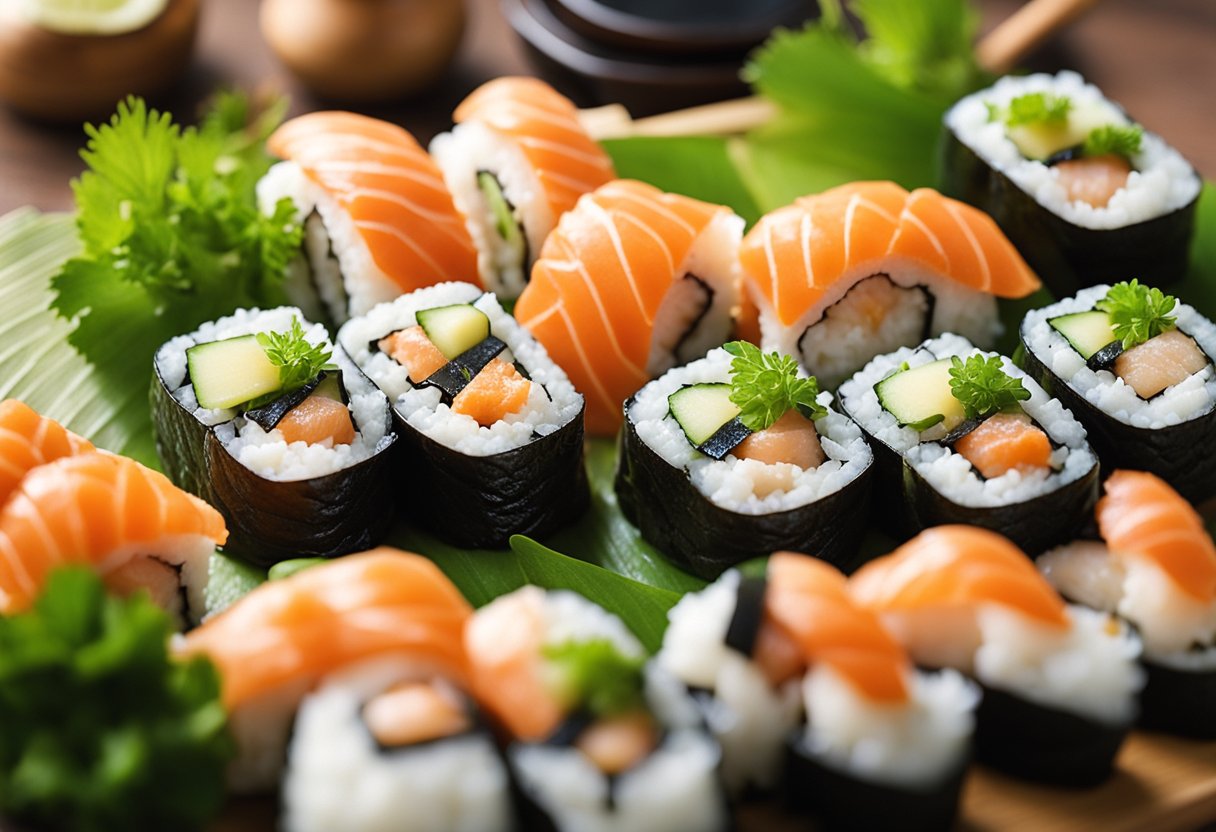
As a sushi lover, I have tasted different types of sushi, and I can tell you that the ingredients used in sushi are diverse and unique. Here are the main ingredients used in making sushi.
Rice
The base of sushi is rice, and it is essential to use the right type of rice. The rice used in sushi is short-grain rice, which is stickier than other types of rice. The rice is cooked with vinegar, sugar, and salt to give it a sweet and sour taste.
Nori
Nori is a type of seaweed that is used to wrap sushi. It is dried and roasted before use, and it has a salty taste.
Vegetables
Vegetables are an essential part of sushi, and they add a crunchy texture to the sushi. Some of the popular vegetables used in sushi include carrots, mushrooms, and avocado.
Protein
Protein is another essential component of sushi, and it can come in different forms. Some popular protein options include tofu, salmon, raw fish, tuna, eel, shrimp, crab, octopus, sea urchin, and crab sticks.
Fillings
In addition to the primary ingredients, sushi can also have fillings such as sesame seeds, horseradish, and red snapper. These fillings add flavor and texture to the sushi.
Condiments
Sushi is often served with condiments such as soy sauce, wasabi, and pickled ginger. These condiments add flavor and spice to the sushi.
Overall, the ingredients used in sushi are diverse and unique, and they come together to create a delicious and healthy meal.
Taste of Different Sushi Types
As a sushi lover, I can attest that sushi has a unique taste that is unlike any other cuisine. The taste of sushi can vary depending on the type of sushi you are eating. In this section, I will discuss the taste of different sushi types.
Maki
Maki is a type of sushi that is made by rolling ingredients in rice and seaweed. Maki sushi has a mild taste and is usually seasoned with vinegar, salt, and sugar.
The flavor of maki sushi can vary depending on the ingredients used. For example, if the maki sushi has avocado and cucumber, it will have a refreshing and mild taste. If it has spicy tuna, it will have a slightly spicy taste.
Nigiri
Nigiri is a type of sushi that consists of a small ball of rice with a slice of fish on top. Nigiri sushi has a sweet and slightly sour taste.
The sweetness comes from the rice, which is seasoned with vinegar and sugar. The sour taste comes from the fish, which is usually seasoned with a mixture of soy sauce and vinegar.
Temaki
Temaki is a type of sushi that is shaped like a cone and filled with various ingredients. Temaki sushi has a refreshing taste and is usually seasoned with soy sauce, wasabi, and pickled ginger. The flavor of temaki sushi can vary depending on the ingredients used.
For example, if the temaki sushi has crab meat and avocado, it will have a mild and sweet taste. If it has spicy tuna, it will have a slightly spicy taste.
Chirashi
Chirashi is a type of sushi that consists of a bowl of sushi rice with various toppings. Chirashi sushi has a sweet and slightly sour taste.
The sweetness comes from the rice, which is seasoned with vinegar and sugar. The sour taste comes from the toppings, which are usually seasoned with a mixture of soy sauce and vinegar.
Inari
Inari is a type of sushi that consists of a pouch of fried tofu filled with sushi rice. Inari sushi has a sweet and slightly salty taste.
The sweetness comes from the rice, which is seasoned with sugar. The saltiness comes from the soy sauce that is used to flavor the tofu pouch.
In conclusion, the taste of sushi can vary depending on the type of sushi you are eating. Maki sushi has a mild taste, Nigiri sushi has a sweet and slightly sour taste, Temaki sushi has a refreshing taste, Chirashi sushi has a sweet and slightly sour taste, and Inari sushi has a sweet and slightly salty taste.
The Role of Condiments and Toppings
As I’ve mentioned earlier, sushi is made of vinegared rice with other ingredients such as vegetables, seafood, and meat as toppings.
However, the toppings alone do not define the taste of sushi. The condiments and toppings play a crucial role in defining the flavor and texture of sushi. In this section, I will explain the role of condiments and toppings in sushi.
Wasabi
Wasabi is a green paste that is served with sushi. It is made from the root of the wasabi plant and has a pungent flavor.
Wasabi is used to add a spicy kick to sushi. However, it is important to note that real wasabi is expensive and hard to come by. Most of the wasabi served in sushi restaurants is actually a mixture of horseradish, mustard, and food coloring.
Soy Sauce
Soy sauce is a salty sauce made from soybeans, wheat, and salt. It is often served with sushi as a dipping sauce. Soy sauce is used to enhance the flavor of sushi. However, it is important to use soy sauce sparingly as it can overpower the delicate flavor of sushi.
Ginger
Pickled ginger is often served with sushi. It is used as a palate cleanser between different types of sushi. Ginger has a refreshing and slightly sweet taste that helps to cleanse the palate and prepare it for the next piece of sushi.
Toppings
The toppings used in sushi play a crucial role in defining the flavor and texture of sushi. Some of the most popular sushi toppings include:
- Fish roe: Fish roe or caviar is a popular sushi topping that adds a burst of flavor to sushi. It is usually made from salmon, flying fish, or trout roe.
- Eel: Eel is a popular sushi topping that has a sweet and savory flavor. It is often served with a sweet soy sauce.
- Tuna: Tuna is a popular sushi topping that has a mild flavor and a firm texture. It is often served with wasabi and soy sauce.
- Salmon: Salmon is a popular sushi topping that has a buttery texture and a mild flavor. It is often served with soy sauce and pickled ginger.
Sweet Soy Sauce
Sweet soy sauce is a type of soy sauce that is sweetened with sugar. It is often served with sushi and is used to add a sweet and savory flavor to sushi.
However, it is important to use sweet soy sauce sparingly as it can overpower the delicate flavor of sushi.
In summary, the condiments and toppings used in sushi play a crucial role in defining the flavor and texture of sushi.
Wasabi, soy sauce, ginger, and sweet soy sauce are some of the most commonly used condiments in sushi. The toppings used in sushi such as fish roe, eel, tuna, and salmon add a burst of flavor to sushi.
Texture and Presentation of Sushi
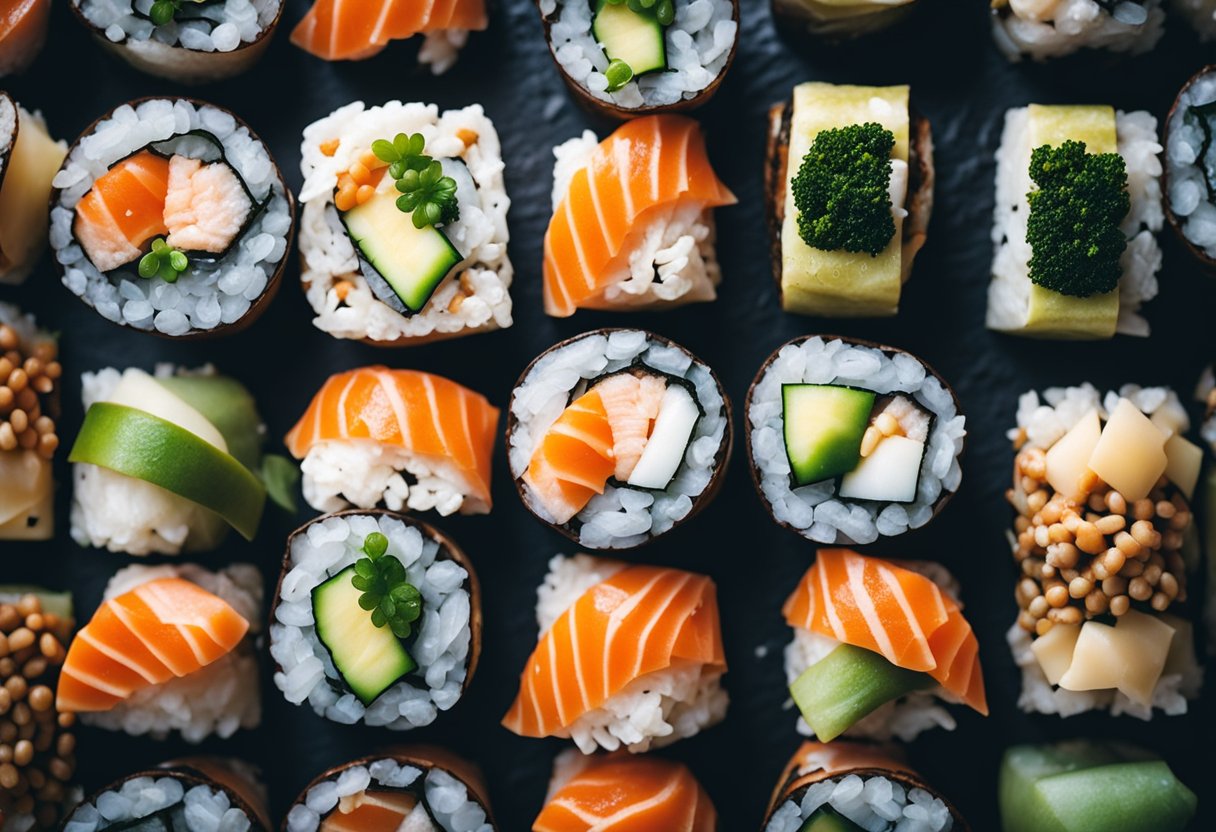
As someone who has tasted sushi before, I can attest that the texture and presentation of sushi are just as important as its taste.
Sushi is often served in small, bite-sized pieces, making it easy to eat with chopsticks or your hands. The size of the sushi pieces also allows for a variety of textures to be experienced in one sitting.
The texture of sushi can vary depending on the ingredients used. The rice used in sushi is often sticky and has a slightly sweet taste.
The fish or other seafood used can range from soft and tender to firm and chewy. Vegetables and fruits used in sushi can add a crunchy texture and a burst of freshness to the dish. The combination of textures in sushi creates a unique and satisfying palate experience.
The presentation of sushi is also an important aspect of the dish. Sushi is often served on a plate or platter, arranged in an aesthetically pleasing manner.
The cone-shaped temaki sushi is a great example of how presentation can enhance the eating experience. The cone shape allows for a variety of ingredients to be layered and rolled together, creating a visually appealing and delicious treat.
Overall, the texture and presentation of sushi play a crucial role in the enjoyment of the dish. The combination of textures and the visually appealing presentation make sushi a unique and satisfying culinary experience.
Eating Sushi: An Experience
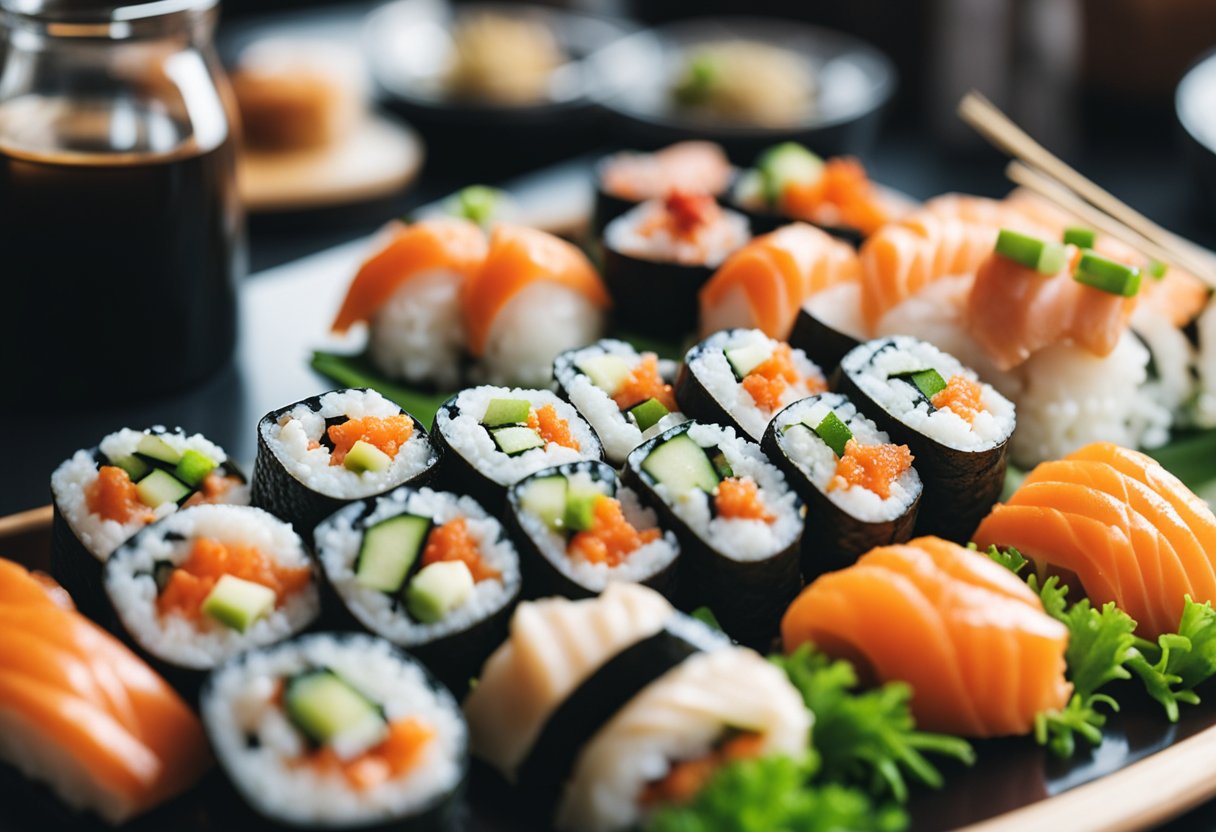
As someone who loves sushi, I can say that eating sushi is more than just satisfying your hunger. It’s an experience that involves all your senses.
First, let’s talk about the presentation. The sushi is usually served on a wooden or ceramic platter, with each piece arranged in a visually pleasing manner.
The colors of the fish, vegetables, and rice are carefully chosen to create a beautiful and appetizing display.
Next, let’s talk about the utensils. Using chopsticks to pick up the sushi adds to the experience. It takes practice to master chopsticks, but once you get the hang of it, it’s a fun and satisfying way to eat.
Some sushi chefs may offer to grill the sushi for you, which adds a unique flavor and texture to the dish.
Now, let’s talk about the taste. Sushi is a perfect balance of flavors. The rice is seasoned with vinegar, sugar, and salt, which gives it a slightly sweet and tangy taste.
The fish is fresh and has a delicate flavor that is enhanced by the wasabi and soy sauce. The vegetables add a crisp and refreshing taste to the dish.
Finally, let’s talk about the sushi chef. A skilled sushi chef can make all the difference in your sushi experience. They know how to select the freshest ingredients and how to prepare them to enhance their natural flavors.
Watching a chef create the sushi right in front of you is a fascinating experience and adds to the enjoyment of the meal.
In conclusion, eating sushi is not just about satisfying your hunger, but it’s an experience that involves all your senses. From the presentation to the taste to the sushi chef, every aspect of the meal adds to the overall enjoyment.
Health Benefits and Nutrition of Sushi
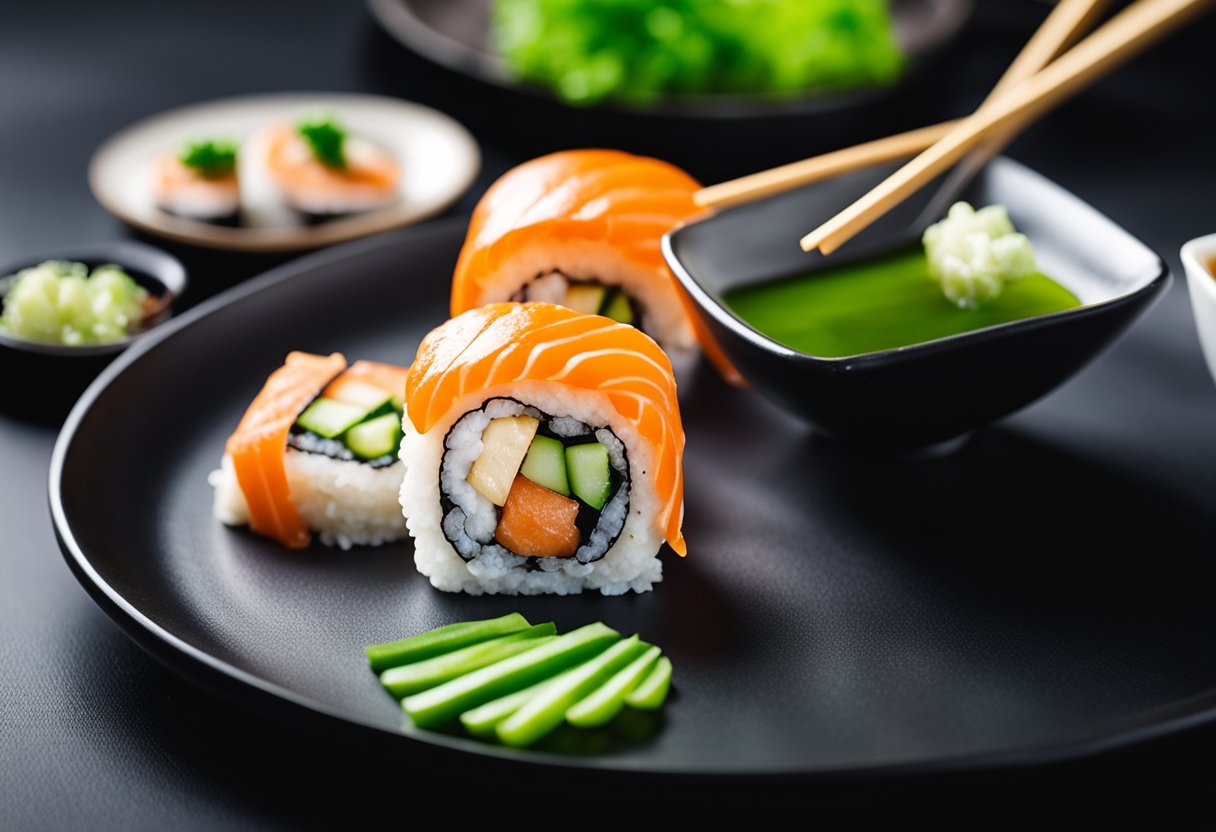
As a sushi lover, I’m always excited to learn about the health benefits and nutrition of this delicious Japanese cuisine. Sushi is generally considered a healthy food due to its nutrient-dense ingredients and low-calorie content.
One of the main health benefits of sushi is its high concentration of omega-3 fatty acids, which are essential for heart health.
Fish such as salmon, tuna, and mackerel used in sushi are rich in these fatty acids, which can help reduce the risk of heart disease, lower blood pressure, and improve brain function.
Sushi is also a good source of protein, a nutrient that is essential for building and repairing tissues in the body. The protein in sushi can help promote muscle growth, boost metabolism, and aid in weight loss.
In addition to protein, sushi is also rich in other important nutrients such as vitamins and minerals. For example, sushi is a good source of vitamin A, which is essential for healthy vision and skin.
It also contains vitamin C, which is important for immune function, and vitamin E, which is a powerful antioxidant that can help protect against cellular damage.
When it comes to carbohydrates, sushi is relatively low in this macronutrient. Most sushi rolls are made with white rice, which is a simple carbohydrate that is quickly digested and absorbed by the body.
However, some sushi restaurants now offer brown rice options, which are a healthier choice as they are higher in fiber and have a lower glycemic index.
Overall, sushi can be a healthy and nutritious food choice when enjoyed in moderation. It is important to note that some types of sushi, such as those made with fried ingredients or high-fat sauces, can be high in calories and unhealthy fats.
Therefore, it is important to choose sushi options that are low in calories and fat and to enjoy them in moderation.
Frequently Asked Questions
What are the different types of sushi?
There are many different types of sushi, but some of the most popular ones include nigiri, maki, temaki, and sashimi. Nigiri sushi is a type of sushi that consists of a small ball of rice with a slice of raw fish on top.
Maki sushi is a type of sushi that is rolled into a cylindrical shape using a sheet of seaweed and filled with various ingredients such as fish, vegetables, and rice.
Temaki sushi is a type of sushi that is hand-rolled into a cone shape using a sheet of seaweed and filled with various ingredients. Sashimi is not technically sushi, but it is a Japanese dish that consists of thinly sliced raw fish.
Does sushi always taste fishy?
No, sushi does not always taste fishy. While most sushi includes raw fish as the main ingredient, there won’t always be strong fishy flavors involved. Sushi is a very mild and neutral flavored food.
The flavors of sushi can be influenced by the type of fish used, the seasoning of the rice, and the other ingredients used in the sushi.
What does salmon taste like in sushi?
Salmon is a popular fish used in sushi, and it has a mild, buttery flavor. When served raw in sushi, the texture of salmon is soft and tender. The flavor of salmon in sushi can be enhanced by the seasoning of the rice and other ingredients used in the sushi.
Is sushi generally sweet or salty?
Sushi can have both sweet and salty flavors. The rice used in sushi is seasoned with vinegar, sugar, and salt, which gives it a slightly sweet and sour flavor.
The other ingredients used in sushi can also contribute to the overall flavor, with some being more salty or sweet than others.
How would you describe the taste of sushi?
The taste of sushi can be described as a combination of flavors – salty, sweet, sour, and umami – with a soft, chewy texture of rice and a variety of toppings ranging from fish to vegetables.
The flavors of sushi can vary depending on the type of fish used, the seasoning of the rice, and the other ingredients used in the sushi.
Is liking sushi an acquired taste?
For some people, liking sushi can be an acquired taste. Sushi is a unique food that can take some time to get used to.
The flavors and textures of sushi can be very different from other types of food, and it can take some experimentation to find the types of sushi that you enjoy. However, many people find that they enjoy sushi right away and develop a love for it over time.







